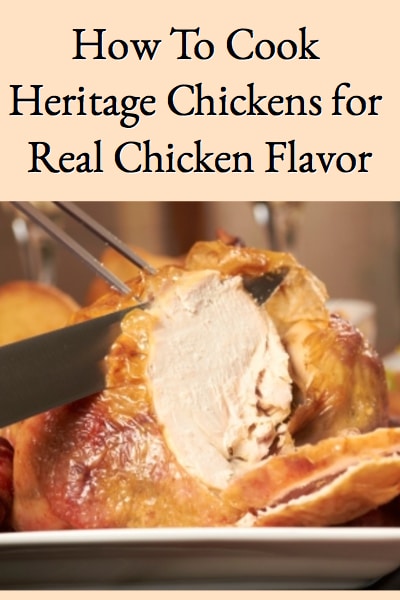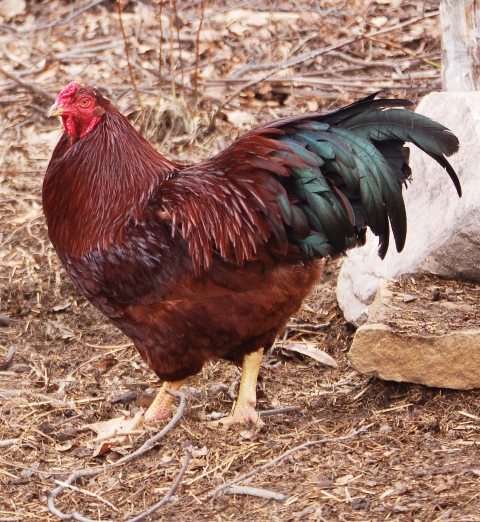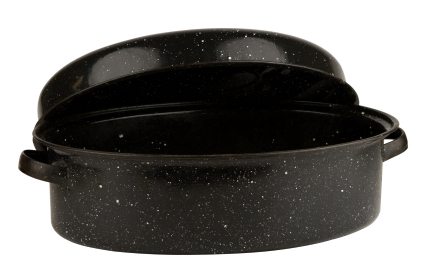Most folks no longer remember how to cook heritage chickens. That’s because the way that the traditional heritage chicken was 
Most commercial chickens grown for meat today have been bred to reach a marketable size in confined space within 9 weeks, thereby maximizing throughput and minimizing costs. If these birds are kept for more than 9 weeks, losses from disease and health issues are high – they have simply been bred for fast production. The problem with birds grown that quickly in tight spaces; however, is that they don’t develop any flavor. Flavor takes time, an active bird, and a bird that has room to move.
Understanding the Traditional (Heritage) Chicken (pre-1940)
Prior to the development of these quickly grown commercial birds, there were four types of birds that everyone recognized – 1) the broiler, 2) the fryer, 3) the roaster, and 4) the stewing bird.
These types were based on the traditional points where pure (heritage) chicken breeds were processed. All of the heritage breeds were expected to produce meat and eggs for the table; and depending on the breed, the farmer would decide when best to process it as a broiler, roaster, fryer, or stewing bird. Although commercial supermarket birds are still called these names; there is no relation to when the birds are processed.
Processing Heritage Chickens
This is how the traditional birds were classified and when they were processed for the table:
Broilers were 7 to 12 weeks old and weighed 1 to 2 ½ lbs.
Fryers were 14 to 20 weeks old and weighed 2 ½ to 4 lbs.
Roasters were 5 to 12 months old and weighed 4 to 8 lbs
Anything older than a year was a stewing fowl

Buckeye Rooster
Broilers and fryers were often excess egg breed cockerels (young roosters) because they wouldn’t attain the carcass size necessary for roasters, and roasters were typically excess cockerels from meat or dual-purpose chicken breeds. Stewing fowl were hens or roosters being culled from flocks as older birds.
Although all the heritage breeds could all be butchered young for fryers or broilers, it was preferred to take time to produce roasters because they had such superior flavor. Today, few remember or understand that the traditional roasting chicken was a meat or dual purpose breed cockerel. The number of eggs produced by young hens made them too valuable for the table, particularly when there were extra roosters that could be used.
Processed heritage birds don’t really look much like modern “roasters”. They’re longer, thinner, have longer legs, and much smaller breasts than the supermarket birds. Because they’re older than the supermarket birds, they also require different handling and cooking techniques.

Traditional Graniteware Roasting Pan
After processing, and before freezing; it’s recommended that heritage chickens be “aged” in the refrigerator to attain the best texture. Aging is typically from 24 hours to 3 days before freezing, depending on the age of the bird at processing. At least 24 hours is usually recommended for roasters, and 3 days or more for stewing fowl.
Cooking Heritage Chickens
When cooking heritage birds, it’s important to realize that these birds have had much more exercise over a longer time than supermarket chickens. This produces flavor but also increases the cooking time needed to tenderize those exercising muscles. Overcooked breast meat or undercooked leg meat can be a problem.
The traditional names indicate the best method for cooking each age of heritage bird:
- Broilers, being young and tender, can be cooked quickly in the dry heat of a broiler or outdoor grill
- Fryers are slightly older and more flavorful, so are usually divided into pieces to achieve both tender and cooked portions using dry heat methods like frying
- Roasters and stewing fowl have sufficient age to be really flavorful, but lower temperatures and moist cooking techniques are needed. The old graniteware roaster with the tight-fitting lid was designed to cook a whole heritage roaster so that the meat would be both moist and tender. Temperatures of 300 – 325° F for 30 minutes per pound are generally recommended. Stewing fowl must be kept moist and the cooking temperature should be kept below 180° F; however, if these conditions are met a very flavorful and tender meat is produced.
Each year when we raise Buckeye chickens, we look forward to some great heritage chicken dinners!
Monika Popein says
This is an excellent article describing how to best cook a heritage cockerel and at what age!
Of Goats and Greens says
My black and red broilers, which I got as day old chicks May 3rd, are going to be harvested next week. Six of 7 are roosters. I would have done this sooner, but the earlier person who was to teach me had to change his plans, so it’s now next week, with someone else. I thank you for the discussion, and I note I should be able to harvest on my own much earlier next year… and I’m considering ordering Buckeye males for that. I just need someone with expertise here the first time ’round, to guide me through and teach.
I suspect I’ll be doing a lot of coq au vin!
Brian says
We own a small heritage breed hatchery in northern Alberta and every year we look forward to all of our “extra” roosters! I don’t think I’ve bought commercially raised poultry in about 4 years.
Mitchell says
Thanks always for the updating the readings.